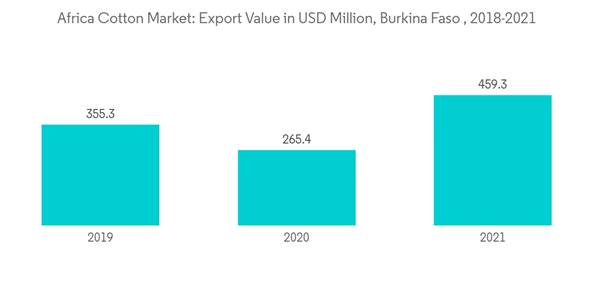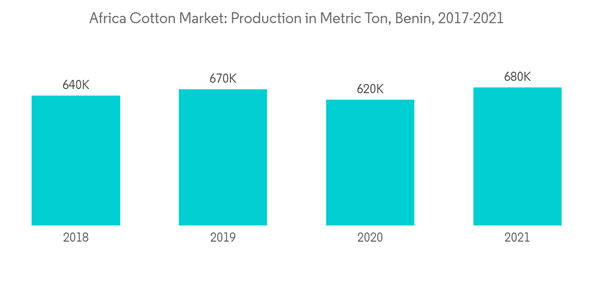Key Highlights
- Cotton is almost entirely cultivated by smallholder farmers in Africa, with very few major plantations. Cotton is frequently farmed as a supplemental commercial crop alongside staples grown for subsistence. However, only in a few places in Africa is the genetically modified cotton crop permitted to grow. Smallholder farmers exclusively plant genetically modified cotton in South Africa, Sudan, and Burkina Faso in Sub-Saharan Africa. African cotton farmed by smallholder farmers is primarily hand-picked, ensuring its high quality.
- Benin, Mali, Burkina Faso, and Ivory Coast are the highest cotton-producing countries in Africa and account for about 50% of the region's produce. Major importers of African cotton are Bangladesh, Vietnam, China, and Malaysia. Cotton grows well in a warm and moist climate where summer is long and where there is salinity in the soil. This makes Sub-Saharan Africa one of the largest cotton producers worldwide.
- Cotton in Africa has generally grown alternately with other crops, such as the basic food crops maize, soy, or groundnuts, which reduces soil leaching and pests. One of the principal organizations offering global cotton production standards is the Better Cotton Initiative (BCI). BCI is bringing an integrated approach to tackling the vulnerabilities of the complex supply chain to ensure the industry's sustainability in the region.
Africa Cotton Market Trends
Increasing Demand for African Cotton in Textile Industry
- There are agreements between Sub-Saharan Africa and the United States that benefit the African textile sector. The African Growth and Opportunity Act (AGOA) focuses on growing commerce in Sub-Saharan Africa and includes 34 African countries, such as Namibia and Rwanda. This statute makes African products more appealing and accessible by allowing them to be included in duty-free shops worldwide, thereby expanding the market for cotton.
- Companies such as H&M have established mills in Africa because the wages are lower and the population can support the workers required. They also make thread and yarn for global markets from cotton grown and harvested in Africa.
- The textile industry's increasing utilization of natural fibers, such as cotton, is driving the export of cotton from African countries. Also, cotton is one of the top 5 export commodities for a few countries, such as Mali and Burkina Faso. Burkina Faso is the largest exporter of Africa, which exported USD 459.3 million value of cotton in 2021.
- Most of the cotton and cotton fabric was destined for Asian countries like Bangladesh, India, Malaysia, Vietnam, and China. Cotton is the most popular type of fabric used due to its versatility in these countries. It is lightweight, comfortable to wear, affordable, and one of the best to wear in the hot and humid climate of the Indian Sub-continent.
Western Africa Dominates the Production in the Region
- Western Africa (WA) comprises twelve cotton-producing countries: Benin, Burkina Faso, Cameroon, Central African Republic, Chad, Côte d'Ivoire, Ghana, Mali, Niger, Nigeria, Senegal, and Togo. The Foreign Agricultural Service of the USDA reported that of the twelve nations, Mali and Burkina Faso are the largest producers and are forecast to have record crops amid expanding areas.
- Mali recorded its highest-ever cotton production of more than 750,000 Metric tons for the 2021-2022 season. Western Africa accounts for more than three-fourths of Africa's cotton exports. Nearly all West African cotton is exported, as mills are relatively sparse within the region, signifying the pivotal role that foreign demand plays for West African producers. It is due to the robust growth in consumption in the South and Southeast Asian regions that they are the major importers of West African cotton.
- Cotton production is usually practiced through a chemically intensive production system that harms human and environmental health. In Western Africa, initiatives are being taken to increase organic cotton production that offers a safer and more profitable alternative, with up to two to three times more profit and safe, biological forms of pest control and soil fertilization. This is expected to increase the demand for Western African cotton in the forecast period.
Africa Cotton Industry Overview
Additional Benefits:
- The market estimate (ME) sheet in Excel format
- 3 months of analyst support
This product will be delivered within 2 business days.
Table of Contents
Methodology

LOADING...










